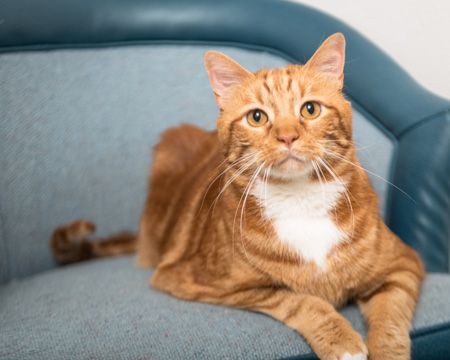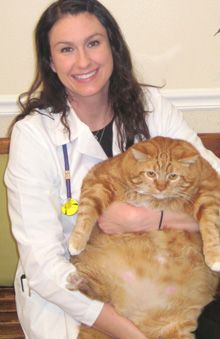Getting the fat off Skinny
How a 41-pound feline shrunk to 19 pounds-and how his success can help your overweight patients.

Sitting pretty: Skinny shows off his 22-pound weight loss. (Photos courtesy of Dr. Brittney Barton)

Dr. Brittney Barton and Skinny when he was at his heaviest: 41 pounds.When Skinny the cat first entered Dr. Brittney Barton's life, he could barely stand on his feet for three seconds. That was all he could handle as 41 pounds overtook his feline frame.
Stop a second and think about that-41 pounds?! A quick Internet search shows several things that weigh about 41 pounds: a typical 3-year-old child, a five-gallon bucket of water, an average microwave, 3 stone (if you're a Brit). But a cat?
You may have seen Skinny in the media, likely the most famous overweight cat. Videos of Skinny have gone viral, earning him international media attention ranging from a Good Morning America cameo, a satellite interview with a show in Australia and a mention in the German magazine Closer. Even The Associated Press has followed Skinny through his weight loss journey, most recently with a story on how he has lost half his size-he's now at 19 pounds, a 22-pound weight loss.
That kind of weight loss is impressive for any species. However, it is especially critical to veterinary medicine where the obesity epidemic in our pets keeps growing.
Skinny's start
Barton says that much about Skinny's backstory is a mystery. Skinny was surrendered to the Richardson Animal Shelter in Richardson, Texas, for care with no clue as to whom had previously owned him or how he came to weigh 41 pounds.
The Richardson Animal Shelter chose his oxymoron of a name and quickly identified the serious need for immediate and consistent veterinary assistance to help Skinny lose weight safely. They transferred his care to the East Lake Pet Orphanage in Dallas, where Barton volunteered to help oversee Skinny's medical care and weight loss program.
Barton and a team of volunteers worked to create a healthy environment that focused not only on weight loss, but on environmental enrichment and appropriate hygiene, as well. After worrying over Skinny for months and eventually fostering Skinny in her home, Barton and her family were smitten. They adopted Skinny in early 2013.
Skinny's weight loss journey has continued for the last 30 months. Barton says, “He is naturally a larger feline, and had he not gained so much extra weight, he would have easily been a healthy 17-pound cat. The goal was to help Skinny lose on average one pound of weight per month to avoid fatty liver disease and drop him to a safer weight.”
The positive side of a voracious appetite
Skinny is incredibly food-motivated, and this trait is what helped Barton and her team achieve such marked weight loss. Barton opened her own practice in Dallas in 2013-HEAL Veterinary Hospital-Health, Enrichment, Advocacy and Longevity. This is where most of Skinny's weight loss has taken place.
In her practice, Barton embraces all aspects of pet care-from traditional medical treatments to a robust physical rehabilitation program and even acupuncture. Skinny's successful weight loss can be attributed to this more integrative approach.
His weight loss regimen has included walking on an underwater treadmill and a regular treadmill, jumping through hula hoops, feeding through treat puzzles (see Skinny in action in the video below) and more. Barton also used acupuncture to help improve Skinny's comfort level at the beginning of his weight loss journey.
How do you get a cat to walk on a treadmill, uphill at that? Here's where the voracious appetite comes in. Skinny is so food-motivated that if you place a couple of morsels of food at the end of a treadmill, he will walk to get them, devour them as he rides to the back of the treadmill and then walk right up again to get the next bit of food.
Quick tip from Dr. Barton
Don't have a treadmill? Ask clients to try moving their cats' food bowl around to encourage “hunting” for their meals. You can also ask clients to try feeding their portly feline with a treat ball to further encourage movement.
A rare case as an ideal illustration
In a time when fat pets are almost revered on the Internet, Skinny stands as an example of how too many pounds is not something to promote. Dr. Barton says fans on Skinny's Facebook page give him credit for inspiring them to seek help for their pets and even themselves. You, too, can use Skinny's story to help motivate pet owners to help their pets shed some pounds.
What are the keys to weight loss as Barton sees it? She says that the concept for pets is the same as for people-calories in, calories out. It's paramount to measure how much pets are fed. Once owners start to see how much their overweight pets are really receiving daily, they finally understand that they have been feeding too much.
Treat replacements are a great help as well. “I recommend frozen blueberries or frozen green beans for dogs and using food as treats for the food-motivated cats,” says Barton.
“But we can't just fix it with food,” says Barton. “Daily activity is important. I have clients keep activity and food journals.” These journals help clients get in touch with what their pets are-and aren't-doing at home, along with how much they are really eating throughout the day.
“I also encourage owner's to use activity tracking apps to identify how far and how long they are walking with their pets,” says Barton. “Coupling this information with a calculated appropriate daily calorie intake is a great first step to developing a weight loss program.”
Barton has patients on a weight loss plan come in monthly for reassessment. Seeing the number on the scale decline is great reinforcement for clients that what you are suggesting is actually working. Barton says it is also important to emphasize that the process takes time. “We're in it for the duration,” she says. “It's about quality of life and health, not just getting results.”
Truly skinny Skinny
As for Skinny, the future is bright. The 7- to 8-year-old cat, as Barton estimates him to be, has been stable at 19 pounds for several months. The goal is to maintain this weight, but a little more slow weight loss could still occur. Barton says that Skinny may still look overweight, but he actually has a good body condition score for his frame. It's the extra skin that stretched from his extreme weight gain that disguises his svelte form.
When asked about future skin removal surgery, Barton says, “Unless there is a true medical issue that could be remedied with surgical intervention, there is no reason to consider it. Skinny is happy the way he is right now.”
Skinny has become the HEAL clinic cat, spending his days welcoming all of the clients and patrolling the halls to make sure all is well. And he gets to go home monthly to spend some time with Barton's family. Barton's goal is to keep Skinny active and stimulated, with some good relaxation time mixed in. After all his media attention, he probably needs it.